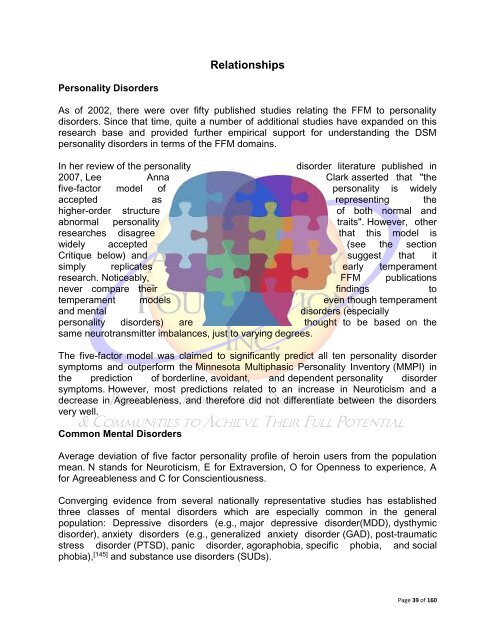The Gift of Introversion
The Gift of Introversion
The Gift of Introversion
Create successful ePaper yourself
Turn your PDF publications into a flip-book with our unique Google optimized e-Paper software.
Relationships<br />
Personality Disorders<br />
As <strong>of</strong> 2002, there were over fifty published studies relating the FFM to personality<br />
disorders. Since that time, quite a number <strong>of</strong> additional studies have expanded on this<br />
research base and provided further empirical support for understanding the DSM<br />
personality disorders in terms <strong>of</strong> the FFM domains.<br />
In her review <strong>of</strong> the personality<br />
disorder literature published in<br />
2007, Lee Anna Clark asserted that "the<br />
five-factor model <strong>of</strong> personality is widely<br />
accepted as representing the<br />
higher-order structure <strong>of</strong> both normal and<br />
abnormal personality traits". However, other<br />
researches disagree that this model is<br />
widely accepted (see the section<br />
Critique below) and suggest that it<br />
simply replicates early temperament<br />
research. Noticeably, FFM publications<br />
never compare their findings to<br />
temperament models even though temperament<br />
and mental<br />
disorders (especially<br />
personality disorders) are thought to be based on the<br />
same neurotransmitter imbalances, just to varying degrees.<br />
<strong>The</strong> five-factor model was claimed to significantly predict all ten personality disorder<br />
symptoms and outperform the Minnesota Multiphasic Personality Inventory (MMPI) in<br />
the prediction <strong>of</strong> borderline, avoidant, and dependent personality disorder<br />
symptoms. However, most predictions related to an increase in Neuroticism and a<br />
decrease in Agreeableness, and therefore did not differentiate between the disorders<br />
very well.<br />
Common Mental Disorders<br />
Average deviation <strong>of</strong> five factor personality pr<strong>of</strong>ile <strong>of</strong> heroin users from the population<br />
mean. N stands for Neuroticism, E for Extraversion, O for Openness to experience, A<br />
for Agreeableness and C for Conscientiousness.<br />
Converging evidence from several nationally representative studies has established<br />
three classes <strong>of</strong> mental disorders which are especially common in the general<br />
population: Depressive disorders (e.g., major depressive disorder(MDD), dysthymic<br />
disorder), anxiety disorders (e.g., generalized anxiety disorder (GAD), post-traumatic<br />
stress disorder (PTSD), panic disorder, agoraphobia, specific phobia, and social<br />
phobia), [145] and substance use disorders (SUDs).<br />
Page 39 <strong>of</strong> 160

















